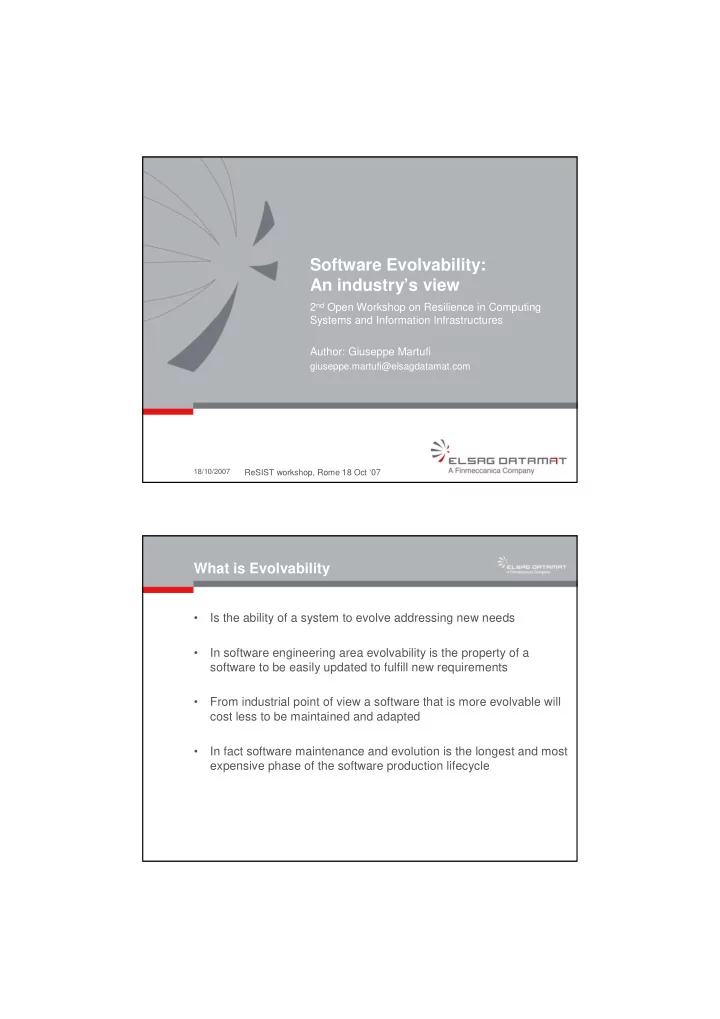

Software Evolvability: An industry’s view 2 nd Open Workshop on Resilience in Computing Systems and Information Infrastructures Author: Giuseppe Martufi giuseppe.martufi@elsagdatamat.com 18/10/2007 ReSIST workshop, Rome 18 Oct ‘07 What is Evolvability • Is the ability of a system to evolve addressing new needs • In software engineering area evolvability is the property of a software to be easily updated to fulfill new requirements • From industrial point of view a software that is more evolvable will cost less to be maintained and adapted • In fact software maintenance and evolution is the longest and most expensive phase of the software production lifecycle
Main topics involved in Evolvability • Programming Models & Software Architectures: – Programming Models (modularity, OO) – Distributed Components Architecture (RMI, CORBA, DDS, Web-Services, SOA) • Software Engineering: – Development model – Design patterns – Modeling Languages (UML, SDL) • Programming Languages (C++, Java, C#) Programming Models & Evolvability Machine level Procedural Object-Oriented Programming Programming Programming (very poor evolvability) (improved evolvability) (enhanced evolvability) Structured Modular SOA Programming (strong evolvability) Programming (poor evolvability) (better evolvability)
Component based architectures & Evolvability • A component-based application is evolvable if it is easily possible to exchange individual components without changing the others. • Component “distance” is increasing: – a first stage all components were contained inside a file – in a second stage components have been spread out over a file system – the third stage is based upon components distributed over the network – in a fourth stage web-based service components are located in different administrated networks and domains, or the Internet (Web 2.0) http://www.omg.org/ http://www.oasis-open.org/ New development models and Evolvability: Open Source • Open Source is a community model • Software development is distributed among programmers that enrich a common product • Each programmer reuses existing code and improve components/applications based on his own needs • Frequent sw releases and nightly builds contribute to fast evolution of a product • Example: GNU/Linux, Apache web server, tomcat, JBoss AS http://www.gnu.org/ http://www.opensource.org/
New development models and Evolvability: Agile programming • develop software in short amounts of time (iteration) • iteration includes all the steps of a software project (planning, requirements analysis, design, coding, testing, and documentation) • a single iteration could not generate a product having all requested functionality, but an intermediate release • at each iteration software product can be adapted to the emergent state of the project ���� http://www.agilealliance.org/ ������ ����� New development models and Evolvability: Extreme Programming (XP) • XP encourages starting with the simplest solution. Extra functionality can then be added later. • It focuses on designing and coding for the needs of today instead of those of tomorrow • XP can produce evolvable sw: – a system made for today does not mean a system closed to the future – possible future requirements might change before they become relevant – an evolvable approach does not require to address today all future requirements, but to be easy adaptable to new requirements arising tomorrow http://www.extremeprogramming.org/
Impact of sw Evolvability in Resilience systems • an evolvable software can be: – easily adapted to new security requirements – fast to react to new threat – clustered and virtualized • open sources evolution leverage to the experiences of all communities and users • fast-iteration model reduce the time-to-react of a sw solution • distributed component architecture spread services on the network increasing separation and reorganization Industrial point of view • Produce evolvable (adaptable) software allow to: – reduce maintenance and adaptation costs – improve the time-to-market – easy introduce changes according to requirements • To produce evolvable products – modularity and component based approach are mandatory – adopt standard approach, models, architecture and well know design patterns – optimize documentation • It does not exist the best formula for software engineering, the better choice is the one supported by experience and needs
Industrial point of view: evolvability best practices • new requirements are inevitable • minimize the effort and the time to adapt to changing requirements • changes of sw needs discipline: – compliance to standards (using widely accepted tools, models and processes) – simplicity (by adopting well know practices in design and implementation) – modularity (by using components) – openness (by allowing the sw to be adaptable in next releases) – clearness (provide documentation not only of the sw, but about its evolution too, face-to-face interactions) Conclusions • Evolvability is one of the key factors for reducing software cost while empowering existing applications/components • Industry, which is ever looking for new way of reducing costs while increasing functionalities of offered components, is defining new business models that are based upon new generation components
Titolo - Arial bold 24 pt. Thanks for your attention 18/10/2007 ReSIST workshop, Rome 18 Oct ‘07
Recommend
More recommend